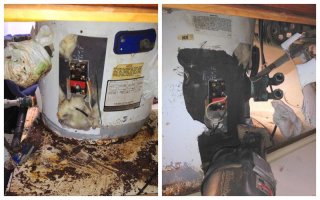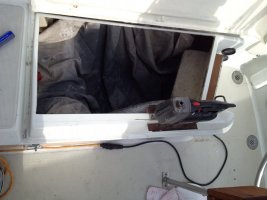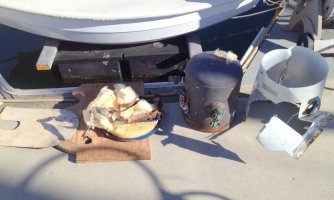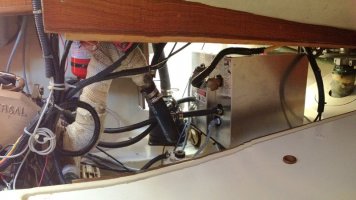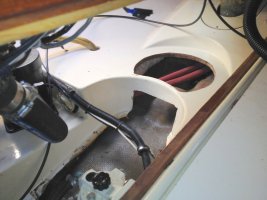Retired from newspapers and television, currently sailing Thelonious II, a 1984 Ericson 381.
The 1985 Raritan 6-gallon water heater still worked without complaint, heating fine while under power and keeping the water warm until breakfast the next morning. The electrical heater no longer functioned, but then I never had cause for hot water when plugged in to a yacht club slip. Perhaps hitting the reset button was all it needed--or a new element.
The problem was that this robust unit, with a glass-lined steel tank and well insulated aluminum jacket, had been manufactured with a weak point--a painted steel hold-down bracket. And so the old soldier began to fade away years ago. It were his boots gave way, that's all, down in the soggy trenches by the bilge. The rest of him kept marching on, though lately through a deepening slough of muddy rust. And so, out comes the Sawzall for the ignominious end that awaits us all.

The usual issue is how to get the old unit out and the new one in. The likely exit is the cockpit seat locker. My opening was 13". The Raritan diameter is more than 15". This raises the old question of how our boats were built. On mine, the heater was clearly installed before the engine was, or perhaps the deck. However, by sawing away the aluminum jacket and removing the insulation, the girth of the heater is reduced to a little more than 13". This is accomplished while sprawled face down in the after berth as the reciprocating saw makes the aluminum dance to the sound of a Liberty Ship factory. What a mess.
The bare Raritan tank still wouldn't fit out through the cockpit seat. So now we switch to a jigsaw, under considerably less claustrophobic conditions. By Jiminy, there is nothing so much fun as sawing up your boat. And nothing is easier than cutting thick fiberglass with a metal-cutting jigsaw blade: A straight line comes natural, and the edge looks clean and with no need of further dressing. The deep breath and the nervous prayer I always say before doing it is nothing more than superstition.

That made my seat locker opening 14". It was a very good idea to line the interior with a drop cloth before cutting, because the work flings shavings everywhere, and as we all know, cleaning up the bilges behind the engine is one of the most awkward jobs on the boat.
To gain more room in the new opening I disconnected the exhaust hose and the anti-siphon, tied them out of the way, and the old unit lifted out with a half-inch to spare. A helper would save time and calisthenics, but this whole job really doesn't need one. Here's the stuff that came out:

The piece on the left, the cover for the TFG (Tri-axial Force Grid) at the prop shaft, is just a piece of 1/8 Formica. The piece of 3/4 plywood that supported the Raritan was 50 percent delaminated, and I don't think it was marine plywood to begin with. Instead of buying MP and patterning a whole new pad, I just glued it back together and sealed the edges. The screws hold the laminates together anyhow.
I'd always wondered what was under those covers, and found no surprises. Two electric bilge pump hoses are visible, nothing else there. It was good to vacuum out years of junk. It was not so good to contemplate being holed under the TFG, the massive interior structure that, tabbed to the hull, supports the stays and the furniture of the mid-1980s Ericson models. It often approaches half-inch thick, and precludes any possible access to the hull from from the inside of the boat. Wonderful engineering, though.

Choosing a new heater was easy . The current Raritan 6-gallon is too big for my space, and lists for something like $1200. The West Marine/Kuuma is about $275, a cube just under 14". There are also Atwood and Seaward models to choose from for about the same money.
The heater hoses on my M25 are 3/8 inch, with male NPT connectors. However, the Kuuma has 5/8-inch slip fittings for those hoses. I asked around and couldn't find a hose reducer to fit. Since the engine fittings are 3/8, larger hoses hoses wouldn't provide more coolant to the heater anyhow. So in the end I just stuck a piece of 5/8 hose over the existing NPT male fitting and secured it with a hose clamp, then clamped the other end onto the Kuuma. It certainly seems secure. But there is a scenario in which the engine overheats and these hoses become very hot, so a cavalier approach to connections is not advised.
Since the water heater is lower than the fill cap on the engine manifold, an expansion tank is not required. Air in the system will vent at the cap.
With all the junk out it's a good time to reroute, shorten or replace the various hoses for hot and cold water. I stuck with the existing Qest gray hoses and fittings, which I kind of like. I installed a new water pump and cleaned up the manifold lines for the port, starboard and bow water tanks. The new pump, by the way, is much quieter that my old one and brings the system up to shut-off pressure in seconds. Many new pumps have a setting for the pressure cut-off, which can be adjusted so the pump runs no longer than necessary.
One puzzlement for me was whether, and where, to install a check valve on the new water heater. There's much conflicting advice. Some say the hot-water side, some say the cold-water side, Kuuma is silent on the matter, and some heaters have one built into the unit. My old check valve was on the hot water, so I left it there.
With the lines hooked up I turned on the water pump and it took quite a long time to pressurize and bleed the system. I didn't win a prize for alertness by failing to realize there was actually no water left in my boat tanks. Eventually, though, all the air was out and with the water tank full I flipped on the 120 volts. Water started getting warm in about 10 minutes. I started the engine and ran under load for 10 or 15 minutes, which also warmed the water up. So far I've only added about a pint of antifreeze mixture. But then, I lost very little in the change of tanks.
The old Raritan was a rust factory and my old hoses were sticky. The new heater is square and shiny, has better vertical clearance than the old one, and I improved the cable runs of throttle, shift and kill; shortened the water and coolant hoses for the new heater, cleaned away 30 years of dirt and factory sawdust back there and generally have a neater looking bilge behind the engine.
This job had a low priority these past two years, and a low priority was probably what it was worth.
Were it not for the rusted footings, I'd have kept the old Raritan forever.
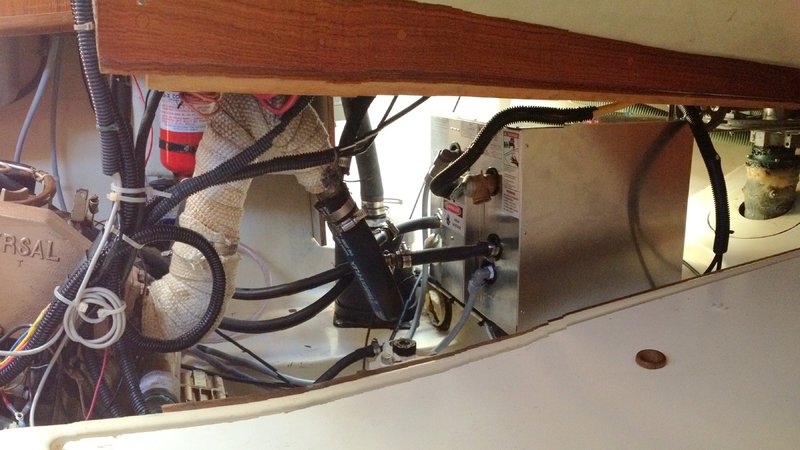
The problem was that this robust unit, with a glass-lined steel tank and well insulated aluminum jacket, had been manufactured with a weak point--a painted steel hold-down bracket. And so the old soldier began to fade away years ago. It were his boots gave way, that's all, down in the soggy trenches by the bilge. The rest of him kept marching on, though lately through a deepening slough of muddy rust. And so, out comes the Sawzall for the ignominious end that awaits us all.

The usual issue is how to get the old unit out and the new one in. The likely exit is the cockpit seat locker. My opening was 13". The Raritan diameter is more than 15". This raises the old question of how our boats were built. On mine, the heater was clearly installed before the engine was, or perhaps the deck. However, by sawing away the aluminum jacket and removing the insulation, the girth of the heater is reduced to a little more than 13". This is accomplished while sprawled face down in the after berth as the reciprocating saw makes the aluminum dance to the sound of a Liberty Ship factory. What a mess.
The bare Raritan tank still wouldn't fit out through the cockpit seat. So now we switch to a jigsaw, under considerably less claustrophobic conditions. By Jiminy, there is nothing so much fun as sawing up your boat. And nothing is easier than cutting thick fiberglass with a metal-cutting jigsaw blade: A straight line comes natural, and the edge looks clean and with no need of further dressing. The deep breath and the nervous prayer I always say before doing it is nothing more than superstition.

That made my seat locker opening 14". It was a very good idea to line the interior with a drop cloth before cutting, because the work flings shavings everywhere, and as we all know, cleaning up the bilges behind the engine is one of the most awkward jobs on the boat.
To gain more room in the new opening I disconnected the exhaust hose and the anti-siphon, tied them out of the way, and the old unit lifted out with a half-inch to spare. A helper would save time and calisthenics, but this whole job really doesn't need one. Here's the stuff that came out:

The piece on the left, the cover for the TFG (Tri-axial Force Grid) at the prop shaft, is just a piece of 1/8 Formica. The piece of 3/4 plywood that supported the Raritan was 50 percent delaminated, and I don't think it was marine plywood to begin with. Instead of buying MP and patterning a whole new pad, I just glued it back together and sealed the edges. The screws hold the laminates together anyhow.
I'd always wondered what was under those covers, and found no surprises. Two electric bilge pump hoses are visible, nothing else there. It was good to vacuum out years of junk. It was not so good to contemplate being holed under the TFG, the massive interior structure that, tabbed to the hull, supports the stays and the furniture of the mid-1980s Ericson models. It often approaches half-inch thick, and precludes any possible access to the hull from from the inside of the boat. Wonderful engineering, though.

Choosing a new heater was easy . The current Raritan 6-gallon is too big for my space, and lists for something like $1200. The West Marine/Kuuma is about $275, a cube just under 14". There are also Atwood and Seaward models to choose from for about the same money.
The heater hoses on my M25 are 3/8 inch, with male NPT connectors. However, the Kuuma has 5/8-inch slip fittings for those hoses. I asked around and couldn't find a hose reducer to fit. Since the engine fittings are 3/8, larger hoses hoses wouldn't provide more coolant to the heater anyhow. So in the end I just stuck a piece of 5/8 hose over the existing NPT male fitting and secured it with a hose clamp, then clamped the other end onto the Kuuma. It certainly seems secure. But there is a scenario in which the engine overheats and these hoses become very hot, so a cavalier approach to connections is not advised.
Since the water heater is lower than the fill cap on the engine manifold, an expansion tank is not required. Air in the system will vent at the cap.
With all the junk out it's a good time to reroute, shorten or replace the various hoses for hot and cold water. I stuck with the existing Qest gray hoses and fittings, which I kind of like. I installed a new water pump and cleaned up the manifold lines for the port, starboard and bow water tanks. The new pump, by the way, is much quieter that my old one and brings the system up to shut-off pressure in seconds. Many new pumps have a setting for the pressure cut-off, which can be adjusted so the pump runs no longer than necessary.
One puzzlement for me was whether, and where, to install a check valve on the new water heater. There's much conflicting advice. Some say the hot-water side, some say the cold-water side, Kuuma is silent on the matter, and some heaters have one built into the unit. My old check valve was on the hot water, so I left it there.
With the lines hooked up I turned on the water pump and it took quite a long time to pressurize and bleed the system. I didn't win a prize for alertness by failing to realize there was actually no water left in my boat tanks. Eventually, though, all the air was out and with the water tank full I flipped on the 120 volts. Water started getting warm in about 10 minutes. I started the engine and ran under load for 10 or 15 minutes, which also warmed the water up. So far I've only added about a pint of antifreeze mixture. But then, I lost very little in the change of tanks.
The old Raritan was a rust factory and my old hoses were sticky. The new heater is square and shiny, has better vertical clearance than the old one, and I improved the cable runs of throttle, shift and kill; shortened the water and coolant hoses for the new heater, cleaned away 30 years of dirt and factory sawdust back there and generally have a neater looking bilge behind the engine.
This job had a low priority these past two years, and a low priority was probably what it was worth.
Were it not for the rusted footings, I'd have kept the old Raritan forever.


